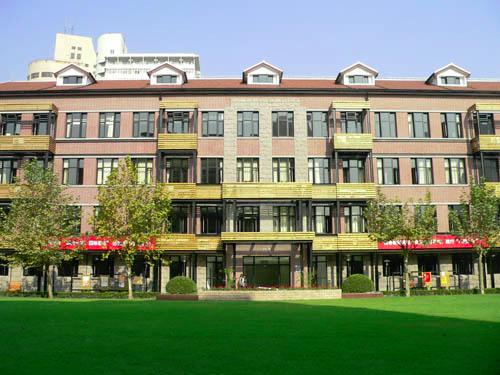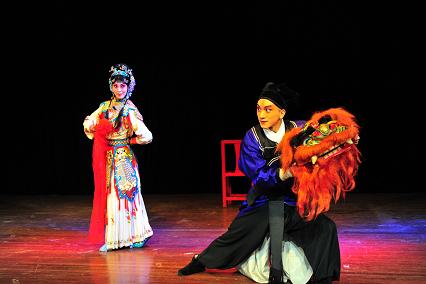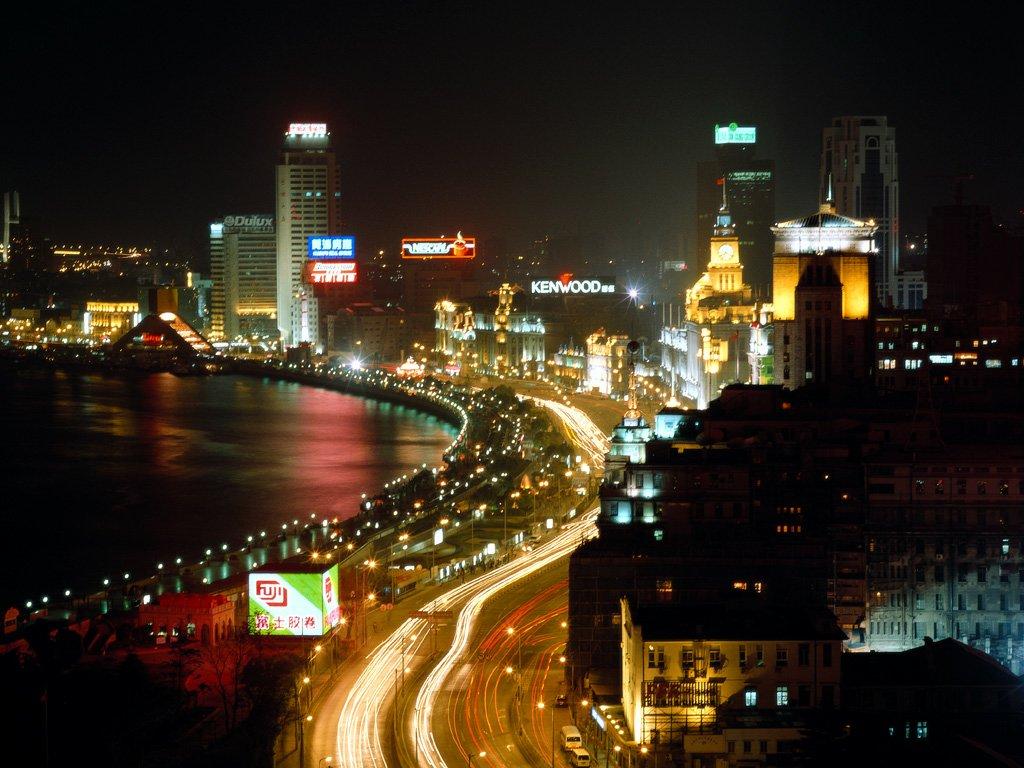 |
Learning Resources
Autumn at STA
Course Syllabi
1. East Acts West
This course encompasses poetic and stylized movements of traditional Chinese theatre with innovative acting idea and styles of Konstantin Stanislavsky, Bertolt Brecht, and other western masters. The eclectic movement training incorporates Tai Chi, traditional Chinese theatre acting and movement skill. Scenes from the western canon, such as August Strindberg’s Miss Julie, and/or traditional Chinese Operas and modern Chinese classics, are staged.
Purpose of the course
To offer Western students a different approach mixing Western and Eastern theatrical skills in performing classical western plays, as well as Chinese classics.
Length of the course
12 weeks 3.5 hours x 3 days a week
Time frame of the course
1. Four weeks for intensive traditional Chinese theatre acting and movement training
2. Seven weeks for selected scene work
3. One week for final performance
Reading required
Fei, Faye Chunfang and William Huizhu Sun. “Othello and Beijing Opera:
Appropriation As a Two-Way Street.” TDR: The Drama Review (NYU & MIT Press), Spring 2006.
Sun, Huizhu. "Aesthetics of Stanislavsky, Brecht, and Mei Lanfang." In Chinese
Theories of Theater and Performance from Confucius to the Present. Faye Chunfang Fei, ed. & trans. 170-78. Ann Arbor: The University of Michigan Press, 1999
Sun, William Huizhu. “Performing Arts and Cultural Identity in the Era of
Interculturalism.” TDR: The Drama Review. Summer 2009.
Wu, Zuguang, Huang Zuolin, and Mei Shaowu. Peking Opera and Mei Lanfang.
Beijing: New World Press. 1981
Sample Section of Syllabus: Sept.
Week One: Basic Elements
1 (1)Intro to Beijing Opera: History and Form
(2)Standing, male/female hand gestures, palms and fingers, cloud hands, mountain arms
2 (1)Review
(2)Male/female steps, circle the space, eyes
3 (1)Recap
(2)Vivacious female steps, Clown steps; wrist gestures; Coordination of eyes, hands, and steps
Week Two:Basic Elements, gestures with small props
1 (1)Circle the space, Male/female steps
(2)Basic functions and handling of props; Female: fans & water sleeves; Male: single spear, single sword
2 (1)Review
(2)Postures of folding fan; Gestures of single spear
3 (1)Circle the space, Male/female steps; Review
(2)Postures of water sleeves; Postures of single spear
Week Three:Basic Elements & Combined Routines
1 (1)Eyes, Circle the space, Steps
(2)Folding fan routines, Single spear routines
2 (1)Review Basic Elements
(2)Folding fan routines, Single spear variations
3 (1)Review
(2)Folding fan routines, Single spear variations (additional)
Week Four:Basic Elements & Combined Routines
1 (1)Review folding fan routines & single spear routines
(2)Water sleeve routines; Single sword routines
2 (1)Circle the space, Steps; Review routines of Mon.
(2)Water sleeve routines; Single sword routines(combat)
3 (1)Water sleeve routines; Single sword routines(combat)
(2)Review all previous routines
Two hours per week: Appreciation of Beijing opera scenes
Four hours per week: Script analysis and adaptation of Miss Julie
Some videos of Beijing opera Miss Julie are in: http://blog.sina.com.cn/zhulixiaojie
Message from Beijing Opera Instructor
Shanghai Theatre Academy offers a three-month Beijing Opera Based Program to students from Tisch who are interested in Chinese culture and theatre arts.
Shanghai Theatre academy
Shanghai Theatre Academy is a 64 year-old comprehensive university of performing arts, located in downtown Shanghai. Its Theatre and Chinese opera Studies is a national-level key discipline.
Shanghai Theatre academy
Shanghai Theatre Academy is a 64 year-old comprehensive university of performing arts, located in downtown Shanghai. Its Theatre and Chinese opera Studies is a national-level key discipline.

The course- East Acts West
Beijing opera as China’s national opera draws and presents the essences from all forms of Chinese culture and art, and its actor’s training combines elements of singing, dancing, acting and acrobatics. During the three-month course the students will learn basic movement patterns and vocalization, and then have the choice of performing short pieces from the traditional repertoire or performing scenes from Beijing opera Miss Julie (East Acts West Project). In the latter case, students can learn how the eastern forms can be used to render western classics. At the end of the course students will make a presentation, to be recorded for future reference. They will also be able to try on the authentic Beijing Opera costumes and traditional make-up to truly experience the charm of Chinese traditional theatre art.
Beijing opera as China’s national opera draws and presents the essences from all forms of Chinese culture and art, and its actor’s training combines elements of singing, dancing, acting and acrobatics. During the three-month course the students will learn basic movement patterns and vocalization, and then have the choice of performing short pieces from the traditional repertoire or performing scenes from Beijing opera Miss Julie (East Acts West Project). In the latter case, students can learn how the eastern forms can be used to render western classics. At the end of the course students will make a presentation, to be recorded for future reference. They will also be able to try on the authentic Beijing Opera costumes and traditional make-up to truly experience the charm of Chinese traditional theatre art.

Your Instructor
I have been learning and working in the profession Beijing opera for more than 15 years, and beyond performing Beijing opera I have learnt different genres of western theatre, Indian Sanskrit theatre Kutiyattam, Japanese Noh theatre, Indonesian Wayang Wong to broaden my knowledge of world theatre and theatrical language.
I have been learning and working in the profession Beijing opera for more than 15 years, and beyond performing Beijing opera I have learnt different genres of western theatre, Indian Sanskrit theatre Kutiyattam, Japanese Noh theatre, Indonesian Wayang Wong to broaden my knowledge of world theatre and theatrical language.
I hope this course will help you learn more about the other side of the world and further inspire your theatrical creativity.

2. Arts and Culture of China
Overall Course Objectives
The purpose of the course is to offer a survey of Chinese arts and culture, which may cover a wide range of areas such as history, literature, traditional opera, film, architecture, customs, music, dance, fine art, etc. During the 12-week period, the lecturers will focus on giving the students a tour of all the above-mentioned significant aspects of Chinese arts and culture, helping them get a general picture of this civilization, and more importantly, facilitate their training in the professional courses like Chinese opera training workshop and documentary-making sessions.
Overall Course Description
This introductory course on Chinese arts and culture is designed to open a window to China for western students. Students are enabled to understand more cultural background of the country that they’re living and studying in for 3 months. Their life here will be more smooth and enjoyable with a glimpse of all the most important and catching aspects of Chinese arts and culture. They’ll get a chance to appreciate the host culture and lay a solid foundation for their study and training in the professional courses.
The instruction consists of 36 hours of formal class meetings over a 12-week period. Various teaching methods will be employed-- in-class lectures by resident and guest professors and pair/panel discussions on Chinese arts and culture; if possible, debates on comparison and contrast between Chinese and American cultures. Audio/ visual materials will also be used in class.
Timetable
Week 1: a survey of modern Chinese history
Week 2 & 3: modern Chinese literature
Week 4: Chinese customs
Week 5: Chinese foods
Week 6: Chinese architecture—museums
Week 7: Chinese architecture—gardens
Week 8: Chinese opera
Week 9: Chinese folk arts
Week 10: Chinese clothing
Week 11: Chinese film
Week 12: Chinese music and dance
Assessments
1 term paper, 12 week reaction papers, 1 class report, 1—2 photo project assignments, 1—2 field trips
Film List
1920/30s Chinese films
1940s—the founding of PRC
1950s—1970s
Post-1980s: the Fifth Generation
the Sixth Generation
Hong Kong and Taiwan
Bibliography
Ancient Chinese Architecture (Foreign Languages Press)
An Outline History of China (Foreign Languages Press)
China on Screen—Cinema and Nation (Columbia University Press/NY)
Chinese Gardens (China International Press)
Chinese Folk Arts (China International Press)
Chinese Clothing (China International Press)
Chinese Festivals (China International Press)
Chinese Foods (China International Press)
Chinese Museums (China International Press)
Chinese Kunqu Opera (Long River Press)
Classical Chinese Gardens (Foreign Languages Press)
Fascinating Stage Arts (Foreign Languages Press)
Food and Chinese Culture (Long River Press)
Modern Chinese Art (Oxford University Press)
Peking Opera (China International Press)
Selected Short Stories from China (1991--2000) (Shanghai Literature & Art Publishing House)
The British Museum Book of Chinese Art (British Museum Press)
The Chinese Have a Word for It—the Complete Guide to Chinese Thought and Culture (NTC/Contemporary Publishing Group)
Traditional Chinese Costumes (Foreign Languages Press)
3. Chinese Language
Course Description
This beginning level language course is designed to prepare students for the daily social demands of living in China and to provide access into the host culture. Students are thus enabled to enrich all aspects of their experience abroad by functioning in the host language during field methods exercises, while conducting fieldwork for the Independent Study Project, and when interacting with local contacts and tourism.
Classes and field-based language activities are taught by experienced, professionally trained, native-speaking teachers of foreign language using oral proficiency-based methods. STA courses focus on communicative competence and linguistic functional ability.
Instruction consists of formal classes every morning spread over a 12-week period. Various teaching methods are employed, including in-class discussions on Chinese and American subjects, recitations for aural comprehension, and concise grammar exercises. The intensive Chinese course emphasizes oral expression and listening comprehension, but also includes entry-level instruction in Chinese characters. Students are placed in groups for language instruction and exercises.
Course Objectives
1) To develop basic communication skills in Chinese language through intensive formal instruction and cultural involvement;
2) To provide a grammatical foundation and facilitate language use, with special emphasis on pronunciation, correct syntax, and verbal expression;
3) To develop a level of proficiency in reading and writing formal Chinese;
4) To examine extra-linguistic and paralinguistic features of language use;
5) To develop culturally appropriate language skills.
| Updated:2019.10.31 Clicks:3834

Shanghai Theatre Academy All rights reserved
Hua Shan Campus: 630 Hua Shan Road Shanghai/ Lian Hua Campus: 211 Lian Hua Road/ Hong Qiao Campus:1674 Hong Qiao Road
Hua Shan Campus: 630 Hua Shan Road Shanghai/ Lian Hua Campus: 211 Lian Hua Road/ Hong Qiao Campus:1674 Hong Qiao Road



